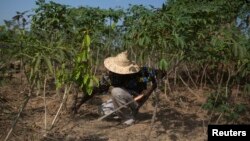Agricultural experts say that small-scale farmers in Africa can play a key role in ending food insecurity in the region - if they are included in the value chain. Small-scale farmers produce an estimated 80 percent of the continent’s food each year, but most lack the capacities to sell their crops in commercial markets.
Sub-Saharan African countries continue to import more food each year than they export. An estimated 60 percent of the world’s uncultivated farmable land is in Africa, but many people still don’t have enough to eat.
Experts say that small-scale farmers could be the key to reducing this food insecurity, as well as stimulating economic growth, and reducing poverty and unemployment.
Adebayo Olukoshi, the director of the U.N.’s African Institute for Economic Development and Planning (IDEP), says small-scale farmers can play an important role in a country’s agricultural development.
“The smallholder continues to be a key player in the African continent. They constitute the bedrock of the agricultural farming population… So it is clear that if the bulk of the agricultural population is of a smallholder nature, than almost by definition, no strategy of food security can be really, truly effective if it does not integrate them fully,” he said.
Global provider
Olukoshi said that not only would more productive smallholders give Africa the potential to feed itself, they could also help African countries serve as a “food basket” for the rest of the world.
But as the number of large-scale industrial farms increases, getting involved in the export market can be near impossible for most smallholder farmers.
“Before you can export, you need to be a big producer," said Edouard Diatta, a rice farmer from Senegal’s southern Casamance region. "Here, in Casamance, we produce just enough to feed ourselves. We grow only what is necessary for our diets. Are there people interested in buying our rice? I don’t know. But even if there were, the quantity we produce now doesn’t allow for exporting.”
The coordinator for West and Central Africa’s Conference of Agricultural Ministers, Baba Dioum, said farmers such as Diatta face four key obstacles when it comes to accessing a larger market.
“The first constraint is that there isn’t good organization among smallholder farmers," he said. "The second is that they don’t have the capacity to manage new technological innovations. The third constraint is that they don’t have the financial means to scale up production. And the fourth is that they don’t have the commercial capacity to be competitive in the global market.”
Game plan
Dioum said many small-scale farmers also depend on rain-fed agriculture. If the rains fail, then the crops fail, and many farmers are reluctant to invest in something that could lose money.
He said that before farmers can scale up, they need to know who they are producing for, and have a guarantee that they can sell what they grow and receive a fair price.
“It would be very difficult for me to produce enough tons to export," said Juliana Diatta, who grows rice and peanuts on a small plot of land in Mossor, a rural village about 45 kilometers west of Ziguinchor. "Sometimes there are problems with rain, or insect attacks. You lose crops. You also need a lot of land, which takes money to obtain. You would need pesticides and fertilizers. And where would you get machines? It isn’t easy without any means.”
Experts say that giving small-scale farmers access to credit or microloans could help them increase their output. Crop insurance might encourage smallholders to scale up their production.
Better agricultural infrastructure, such as storage facilities, irrigation systems and road systems, as well as better access to market information, also is needed.
